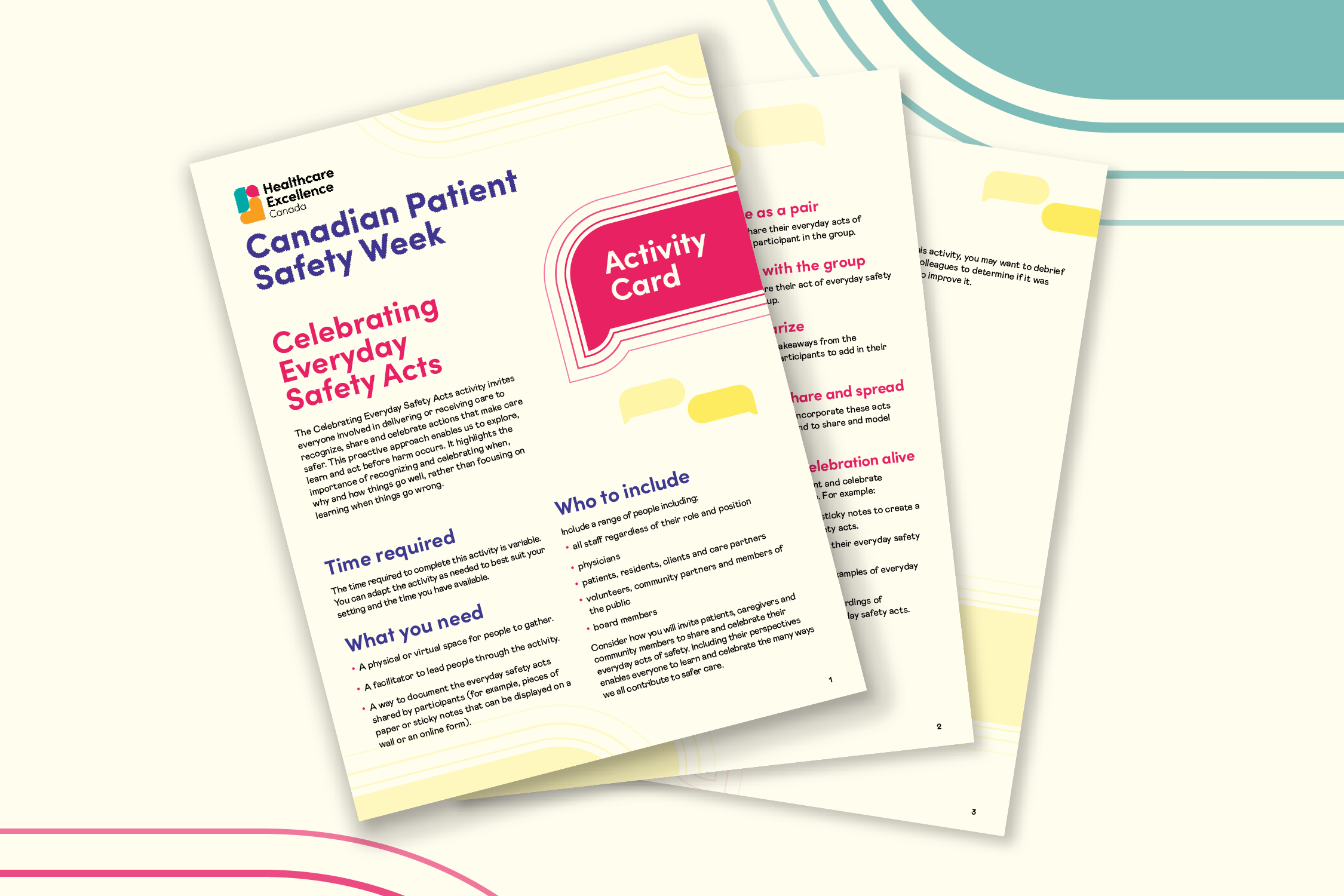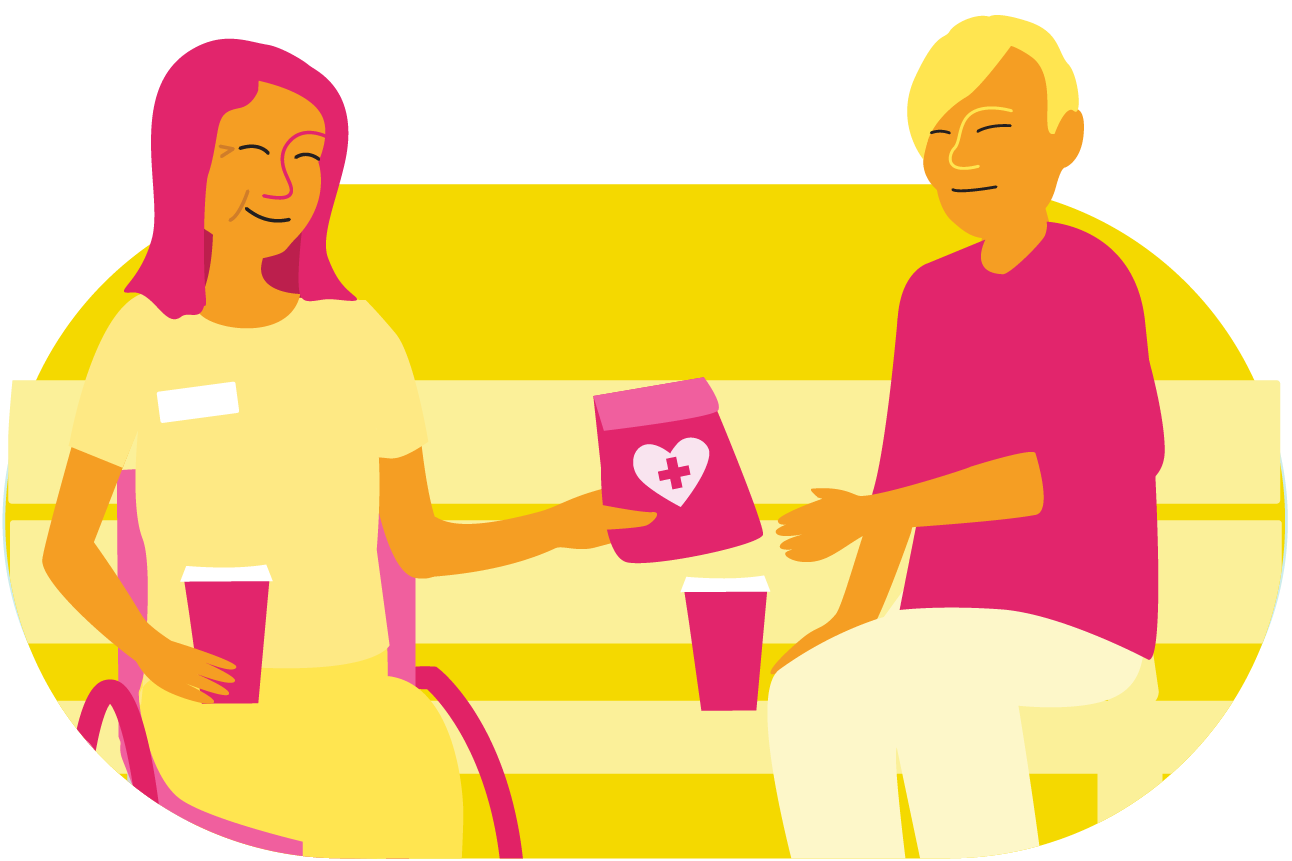The Celebrating Everyday Safety Acts activity card (PDF) invites everyone involved in delivering or receiving care to recognize, share and celebrate actions that make care safer. This proactive approach enables us to explore, learn and act before harm occurs. It highlights the importance of recognizing and celebrating when, why and how things go well, rather than focusing on learning when things go wrong.
Download the activity card (PDF)
What are everyday safety acts?
Everyday safety acts can be simple, proactive behaviours that contribute to safer care. While they may seem small, their consistent use can have a big impact — and together, they help form the foundation of a safer healthcare system. Examples may include:
- A care provider takes a moment to learn how a patient wants to be addressed, including name pronunciation and pronouns.
- A care partner tells their primary care provider about an IT outage that delayed hospital discharge information.
- A patient follows up on delayed test results, preventing a delay in their diagnosis.
- A paramedic offers to remove their boots before entering a home, in line with cultural or spiritual practices.
- A staff member responsible for purchasing supplies ensures they meet all safety standards.
Who this activity card is for
This activity can be used in a wide range of healthcare and community care settings. It is intended to inspire healthcare professionals, patients and care partners to be proactive about patient safety. By exploring, celebrating and spreading everyday safety acts, we can illustrate that small actions can have a big impact and that everyone can play a role in creating safer care.
Why it matters
Too many people continue to experience harm in healthcare, and many voices are still left out of conversations that shape safer care. By making space for all voices — including those who may not see themselves in traditional safety roles — we can broaden our understanding of safety and harm and co-create solutions that drive real change together. When we listen to all voices, and support everyone’s contributions to patient safety, healthcare becomes safer, more inclusive and more effective for all.
Historically, patient safety efforts have focused mostly on measuring and responding to harm. However, safety is much more than the absence of harm. Rethinking Patient Safety encourages us to look at the whole system to understand how to create lasting conditions for safer care. It’s about adopting proactive approaches to establishing safe conditions through every conversation, decision and action, and emphasizing that everyone has a role to play in actively shaping safer healthcare.
This activity builds on the One Safe Act (OSA) concept. In the United States, OSA was developed to foster personal and positive discussions about patient safety in perioperative teams. It is one way of highlighting proactive behaviours and actions staff – regardless of role or position – can take in their day-to-day practice to promote safer care. OSA is one approach shown to promote a positive safety culture and help mitigate burnout among healthcare professionals.
I see safer care in action when...
“Team members speak up about potential risks before they become issues.”
- Quality and Performance Improvement Assistant, Ontario

“Team members speak up about potential risks before they become issues.”
- Quality and Performance Improvement Assistant, Ontario

“When we actively listen to the needs and concerns of patients and families.”
- Administrator (Prince Edward Island)

“When we actively listen to the needs and concerns of patients and families.”
- Administrator (Prince Edward Island)

“Care providers acknowledge and address systemic barriers, tailor services to meet the cultural and historical realities of different communities and create space for community voices in decision-making.”
- Consultant (Nova Scotia)

“Care providers acknowledge and address systemic barriers, tailor services to meet the cultural and historical realities of different communities and create space for community voices in decision-making.”
- Consultant (Nova Scotia)

“I see staff taking extra time and educating patients and their families and caregivers on what to expect during their visit and after their visit and really taking the time to ensure they understand their care plan. I see safer care in action when I see a patient's emotional wellbeing considered in their care plan not just their physical or health condition.”
- Clinical Safety Coordinator (Alberta)

“I see staff taking extra time and educating patients and their families and caregivers on what to expect during their visit and after their visit and really taking the time to ensure they understand their care plan. I see safer care in action when I see a patient's emotional wellbeing considered in their care plan not just their physical or health condition.”
- Clinical Safety Coordinator (Alberta)

Related programs:
{{currentEntry.friendlyTitle.length > 0 ? currentEntry.friendlyTitle : currentEntry.title}}
- {{param_allText}}
- {{decodeURI(filterType.title).replaceAll('+', ' ').replaceAll('%26', '&')}}
- {{param_allText}}
- {{decodeURI(filterType.title).replaceAll('+', ' ').replaceAll('%26', '&')}}
- {{param_allText}}
- {{decodeURI(filterType.title).replaceAll('+', ' ').replaceAll('%26', '&')}}

